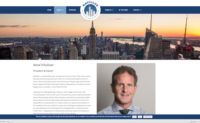Financially Distressed Designer EYP Group Seeks Bankruptcy Protection

Photo: Getty Images/iStockphoto
Since 2016, EYP Group Holdings has completed design work on numerous prestigious health care and educational projects. Founded in 1972, the Albany, N.Y.-based architecture and engineering practice, originally named Einhorn, Yaffee & Prescott, was by all appearances a success, with deep contacts in its home state and good relationships with clients in offices around the country.
Behind the scenes, however, the employee-owned company has been in financial distress, with $149 million of debt, much of it owed to a bank and numerous former managers and staff, according to court documents.
EYP Group Holdings now seeks to end its crisis through protection from both a bankruptcy filing made on April 24 in Delaware federal court, and a pending sale to a private equity investor.
How much its creditors will collect will eventually be determined in court.
According to court documents, the roots of the trouble go back to 2011, when the company needed financing to cash out retiring key staff managers.
EYP Group Holdings has proposed selling its assets to Ault Alliance for $67 million. As part of the plan, Ault would supply $5 million in debtor-in-possession financing.
According to court documents, the roots of the trouble date to 2011, when the company needed financing to cash out retiring key staff managers. An investment by Long Point Capital, a private equity firm, gave it 40% of EYPs stock and provided a cash injection that enabled it to acquire other firms.
Five years later, when Long Point sought to sell its stake, the investor, which had board seats, decided with other EYP Group directors to create an employee stock ownership plan. An ESOP is a tax-protected trust that usually involves shareholders borrowing significant amounts, and numerous EYP Group employees sold shares they held to the ESOP in exchange for notes.
The ESOP was based upon a per-share price of $5,181 and set an enterprise value on EYP Group Holdings and its subsidiaries of $170 million. About $62 million of the ESOP financing was provided by Keybank N.A.
Shortly after the ESOP transaction closed, EYP Group Holdings breached its bank covenants, and since then, was in continuous default and operating under forbearance agreements with its lender.
“The company’s precarious debt position has been well known since almost immediately following the ESOP,” stated Interim CEO Kefalari Mason, in a declaration to the bankruptcy court.
Exactly what happened after the extensive financial scrutiny involved in an ESOP is unclear. “There’s nothing wrong with private equity investment and ESOPs,” noted Nick Belitz, mergers and acquisition specialist for investment banker and AE acquisitions expert Morrissey Goodale. It has no connection to EYP Group, but Belitz points out that private equity investment and ESOPS are increasingly common as successful sources of capital for design firms.
Layers of Note Holders
To effectuate the ESOP, EYP Group created layers of note holders and indemnifications.
The company collectively owes $139 million to 111 note holders, many who are former managers and employees who either held stock or accepted promissory notes taken in lieu of stock or earlier payments owed.
The note holders now are among the biggest creditors listed in the bankruptcy filing, who include Tom Birdsey, an EYP co-founder and former CEO, at $15.6 million, and the estate of Edmund F. Kohlberg, former board member and leader of the firm’s federal government sector, who died in 2015 at age 58. The estate is owed $3.3 million.
Most recently, the company was "under intense pressure,” Mason said in her declaration, from its former senior secured lenders, led by KeyBank, as a loan came due on June 28, 2021.
With all the debt holders and stakeholders unable during three years of out-of-court negotiations to reach a mutually agreed solution, Mason stated that the company “found itself entangled in a further deteriorating situation with its note holders, and mounting liabilities” that threaten the company’s “financial and operational position.”
Adding to the complications, a group of former employees is suing former officers and directors in state and federal court, alleging financial mismanagement and breach of fiduciary responsibilities, some of it connected to the financial decision-making and ESOP share valuation. EYP Group is not party to the lawsuits.
A federal judge recently sent that lawsuit back to state court and, in his order, noted that near the time of its ESOP, former CEO Birdsey was entangled as a potential witness in a contract-steering probe involving associates of former New York Gov. Andrew Cuomo and Alain Kaloyeros, former president of SUNY Polytechnic University. Kaloyeros was convicted of wire fraud and is appealing to the US Supreme Court. EYP Group, which was not charged with wrongdoing, designed a new building at the university in Albany and leased space in it.
Asked if the bankruptcy could cut payouts expected by former employee note holders, EYP Group replied that it is working "to maximize the return to all creditors, including our note holders," and that the steps taken in creating a restructuring plan "that provides for meaningful recoveries for all note holder groups speaks volumes about the company's commitment to our note holders."
Despite the financial woes, the company stated that recent revenue and profit are up, new project bookings hit historic highs and staff recruitment remains busy. An 11th company office, in Orlando, Fla., has opened. And the company has launched a Sustainable Landscapes service line.
The bankruptcy filing and planned sale "is a positive step forward" for the company, Mason added.
This story was updated May 11, 2022, to include comments about the EYP Group ESOP and the federal judge's comment on the SUNY Polytechnic investigation.



